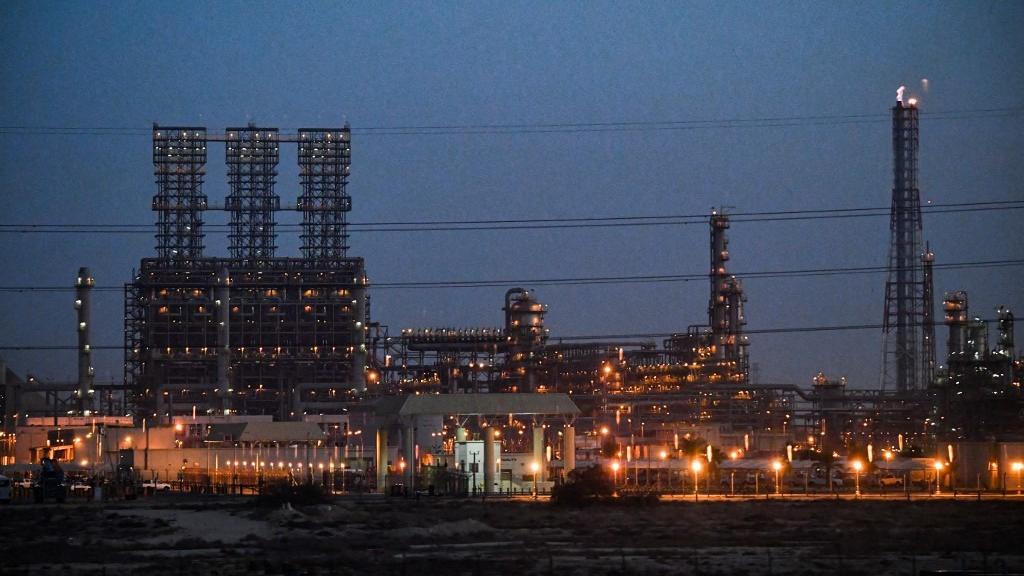 This file photo taken on Dec 11, 2019 shows a view of a refinery at the Jubail Industrial City, about 95 km north of Dammam in Saudi Arabia's eastern province overlooking the Gulf. (PHOTO / AFP)
This file photo taken on Dec 11, 2019 shows a view of a refinery at the Jubail Industrial City, about 95 km north of Dammam in Saudi Arabia's eastern province overlooking the Gulf. (PHOTO / AFP)
HOUSTON - One year ago in June 2022, the average monthly Brent price reached a high of $122.71 per barrel, partly due to the geopolitical tension following the Ukraine crisis.
Since then, Brent price has been on a general slide, dipping to an average of $75.47 per barrel last month, about 22 percent below the monthly average of $97.13 in February 2022.
Will the oil price continue to slide?
Oil demand will continue to grow and peak in 2028, the International Energy Agency (IEA) said on Wednesday, projecting that global oil demand will set a new record of 102.3 million b/d this year and peak in 2028 to 105.7 million b/d, citing China's recovering economy as a key reason
In the past decade, the global oil market experienced two major oil price collapses. Between June 2014 and January 2016, the average monthly Brent price decreased by more than 70 percent from $112 per barrel to $31 per barrel.
ALSO READ: IEA: Growth in global oil demand set to slow markedly by 2028
Again, between May 2019 and April 2020, the average monthly Brent price dropped by more than 70 percent from $71 per barrel to $18 per barrel, partly because the COVID-19 pandemic led to a decrease in the global oil demand.
Both times, oil-producing countries certainly hoped that production cuts would help stop global oil price from further decreasing, as they suffered significant economic hardship since oil exports are key to their income.
"Saudi Arabia wants to stabilize oil price," Abhi Rajendran, director of research and advisory at Energy Intelligence, an energy information company, told Xinhua recently.
Saudi Arabia and its OPEC+ partners announced the latest round of production cuts in early June, hoping that their collective action, coupled with an improved economic outlook and higher oil demand growth forecast, will help to prevent the global oil market from a further downturn.
Saudi Arabia wants to show its determination against the oil speculators who have been betting on a continuing crude price slide, Rajendran observed.
ALSO READ: Firms urged to mitigate oil price risks
Russia is also keen to join the efforts to stop oil price slide, and in April announced that it would extend its own voluntary oil production cut of 500,000 barrels per day (b/d) until the end of 2023. Russian President Vladimir Putin said in May that oil production cuts were needed to stabilize the world oil market price.
In the new quota agreed amongst OPEC+, Saudi Arabia's crude production would be at 10.5 million b/d for 2024, whereas Russia will produce 9.8 million b/d in the same period.
Oil market had a positive initial response to the production cut. Brent price went up by 6 percent from $72.6 per barrel at the end of May to reach $76.95 dollars on June 6.
However, in the following week, the market lost more than all of its price gain. On June 12, Brent set a new 12-month low of only $71.84 per barrel.
As OPEC+ countries are trying to curb oil production, the United States is expected to set a new production record of 12.6 million b/d in 2023, a 6 percent surge from 11.9 million b/d in 2022, according to the June Short-Term Energy Outlook report issued by the US Energy Information Administration
As OPEC+ countries are trying to curb oil production, the United States is expected to set a new production record of 12.6 million b/d in 2023, a 6 percent surge from 11.9 million b/d in 2022, according to the June Short-Term Energy Outlook report issued by the US Energy Information Administration (EIA).
ALSO READ: Riyadh eyes big oil cuts in July, OPEC+ extends deal into 2024
The EIA report also suggested that the oil price will be stabilized after struggles, forecasting an average Brent price of $80 per barrel for 2023, and $84 per barrel for 2024.
The US crude oil production was growing at a double-digit pace two years in a row before the pandemic and set the record of 12.3 million b/d in 2019.
Since the last oil price downturn in 2020, US oil producers have turned their focus more to capital discipline, share buybacks and shareholder return, rather than pure production growth, according to local energy experts.
Looking into the future oil price moves, the forecast growth of global economy and related oil demand always plays a critical role.
Oil demand will continue to grow and peak in 2028, the International Energy Agency (IEA) said on Wednesday, projecting that global oil demand will set a new record of 102.3 million b/d this year and peak in 2028 to 105.7 million b/d, citing China's recovering economy as a key reason.
READ MORE: OPEC cites risks to summer oil outlook, holds demand forecast
However, the average annual growth rate of global oil demand will be considerably lower between 2024-2028, by less than 1 million b/d each year, as the transition to renewable energy accelerates, the IEA noted.
Similarly, the World Bank, in its latest Global Economic Prospects released earlier this month, increased its forecast for 2023 global economic growth to 2.1 percent.
Though the figure was up from the January 2023 projection of 1.7 percent growth for this year, it is still significantly lower than the 3.1 percent growth rate in 2022, as the world faces a high inflation rate and other economic headwinds.
The world needs more economic and geopolitical boosters beyond production cuts to keep oil prices stable, local analysts say.


